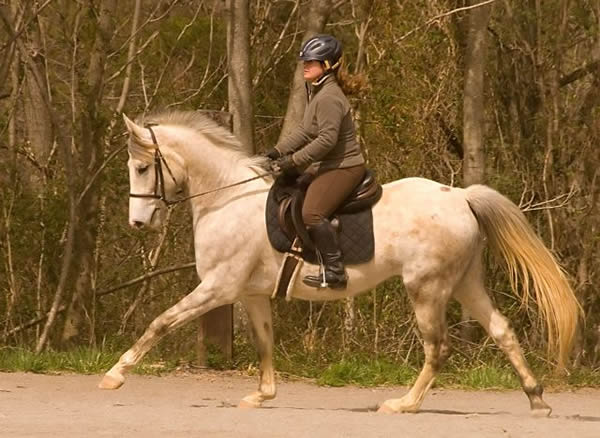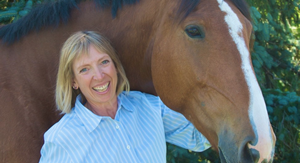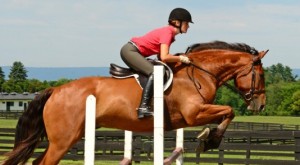I don’t ride every day. I wish I could. In fact if I get on a horse once a week I’m doing well. Well, that is not entirely true either. I actually ride every day. In fact I probably spend most of my day on a horse. Does this sound like a paradox? Well, everything I do in my life I relate to riding. Whether that is driving my car, walking down the street, or modeling for my students.
So I have realized once again the power of practicing without actually riding. I talk about it all the time in my clinics. I explain about the study with the basketball team that improved their free throws without actually shooting a basket or the guy in Vietnam that took several strokes off his golf game and kept himself from going crazy by playing 18 holes of golf while being trapped in a little box for weeks. I also talk about practicing Centered Riding in everything you do from driving the car to washing dishes or dealing with your children. I guess in this case I practice what I preach AND I benefit from the results. That does not mean that I get it right all the time. When I made the mistake of coming home from a clinic on Memorial Day Monday at 7:00 pm on the New Jersey Turnpike, I can honestly state that I was far from “centered”. In fact if any of you were at the toll booth at about 10:00 pm that night (at the New York City end) you may have noticed a completely crazed woman in a blue Acura Integra about to jump out of her car and pound on the hood of some cars on her left trying to cut in front of her. You could at least hear her yelling at the drivers and threatening to ram them. Yes, I must admit it was I.
I am often asked what one can do to improve their riding other than just ride. Here are some suggestions: Practice playing at being a horse – that is right- canter around the yard on the way down to the mailbox. This is not just for kids, I can’t tell you how many adults have no idea how to canter on foot. And they wonder why they have a problem on the horse? Make sure you can canter on both leads (you may be surprised that you favor the one your horse does!) Use your Centered Riding techniques in other facets of your life like driving the car, carrying your school books, sitting in the doctor’s office while waiting for your appointment. You will be amazed to find that you will be less fatigued after a little practice. Spend a little time each day sitting well, such as at the dinner table or in front of your computer. Remember to find your seat bones pointing straight down (you may have to come to the front of the chair as most want to put you too far back), then align your spine, notice your breathing. While you are at it, imagine what it is you would like your horse to do and see him doing it perfectly. You may not be able to perform it that way yet but heck; this is your imaginary experience! Why not go all the way?! When I drive down the road I always listen for good kur music on the CD or radio and make up a ride in my head. What fun playing with canter pirouettes and half-pass! Instead of sitting on a stool or kneeling when you are in low places, do deep knee bends or squats instead. This is a great way to practice your jumping position and strengthen your quadriceps. While you are down there, notice if you can keep your feet flat on the floor (a good test to see if your ankles have enough flexibility). Slowly come halfway to standing and feel the quads work. Then gently imitate the motion of rising trot in a forward position. (A side benefit to this exercise is the toning of your thigh and buttocks!) Be careful if you have knee problems as this can be a bit hard on those joints and make sure you stick your bottom out as you go down and that your knees are aligned with the middle toe of each foot. (Another place to practice this is doing TTEAM leg exercises.)
Notice when you are breathing well, that the diaphragm supports the ribcage from below and the ribs expand outward. Practice walking this type of diaphragm support. You could imagine that you had a tray in your hand. Observe how the torso muscles need to come into use in order to keep the tray level (this will also help tone the internal muscles in your pelvis). Make sure you practice carrying a tray in either hand so that you are balanced on both sides of your body. For that matter, practice mucking your stall the non-habitual way or the opposite way you usually do. You might find that you get frustrated very quickly and want to switch because you are taking so long. Remember that you need to develop both sides of your body if you want the horse to respond equally on both reins.
If you want to put in some real effort, get yourself a minitramp and work out on it at walk, trot and canter. Be careful that you take off your spurs before you mount otherwise you may get bucked off! Put the tramp in front of a mirror and watch to see if you are straight in the shoulders and hips. Check to see if you can bear the weight equally on both legs. It is not necessary to do lots of jumping around on the tramp. Keep your feet close to the surface and letting your joints give. At walk, leave your entire foot on the tramp and just give in the joints. This can be a real eye opener in itself. Notice whether you throw your hips from side to side or if there is little sideways movement. Then decrease the sideways movement and let your knees go forward over your toes. (Sideways movement can indicate a number of issues that appear in riding including problems sitting the canter.)
Other things you can do are the Alexander technique, Feldenkrais and other forms of body awareness exercises such as T’ai Chi. Or take up ballroom dancing. I did for several years and it really straightened out an issue I had about rolling to the outside of my right foot and supporting my weight on my left leg. And it was really fun! A friend of mine, Joyce Harman DVM, has spent less time on a horse than I have lately. I recently gave her a lesson and she has improved tremendously since the last lesson, two years ago, because she has been going to a network chiropractor and walking up a steep hill every day after she feeds her horses.
One last suggestion I would like to make is meditation. Now I know this sounds a little bit “eastern” but let me explain. I have been meditating for 12 years and I have experienced profound changes in my body as a result. So if you can’t connect to the concept for its “peace and calmness” think of it as a great way to improve your seat for riding. Here’s how. The position of sitting with the spine aligned and legs crossed (lotus position is definitely not necessary) helps strengthen the torso perfectly for riding. At first I used to need a wall to rest against and pillows behind my back. Now I can sit for an hour without any assistance because I have sufficiently strengthened the muscles in my abdomen and back while releasing the tension around my hip joints. The result of this release is greater freedom of movement in my hips so that I can sit the trot more fluidly.
Before you know it you will be cantering to the bus waiting for the kids and practicing your side pass heading out to the garbage can, tucking your seat for the perfect slide stop into the traffic light or gently half-halting as you apply the brakes coming into a curve in the road. You will notice that your breathe when you get another one of those harassing solicitation phone calls instead of slamming the phone on the guy’s ear. Perhaps you will find yourself centering as you wait in line at the grocery store instead of wanting to knock everyone down to get to the checkout. Remember, the more se nses you involve, smell, hearing, etc. the more powerful visualizations become. Now if I can just figure out how to visualize melting off 20 lbs. as I travel…… ah well, I guess that comes with practice.
Copyright© 2000. All rights reserved.




